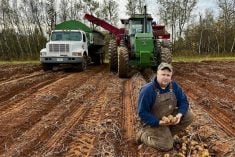Carla and Tyrone Borsa had already put a lot of research into their Rosthern, Sask., sheep operation even before the first set of cloven hooves hit the pasture in 2022.
Almost three years later, that focus on quality sheep production has netted twenty-five mature Dorset ewes and two Canadian Arcott rams.
And although the Borsas are new to sheep production on the Prairies, they are not alone.
Read Also

Riding the tariff roller-coaster
What producers are doing to minimize the risk created by ongoing trade uncertainty.
Gordon Schroeder, executive director of the Saskatchewan Sheep Development Board, says that the sheep industry is growing provincially and nationally.
While the board doesn’t collect official demographic statistics from their producers, judging by those participating in shows and taking part in workshops, Schroeder puts the average age of sheep producers between 30 and 40 years old. This is far from the national average age of 56 in 2021, and 55.8 for Saskatchewan alone.
The development board is seeing a lot of young people get into sheep because of lower entry costs.
Much lower capital costs than other sectors is one reason Carla and Tyrone Borsa chose sheep. Sheep also require less land compared to other livestock and government entry grants were available to help the family get started.
“The biggest expense is normally the breeding animals,” says Schroeder. “Sheep don’t need a lot of facilities and they’re not hard on facilities, so you can accommodate sheep in just about anything you have.”
Growing up on a cattle farm, Carla knew she wanted to raise her two young children with farm animals but needed a livestock operation that would be conducive to their children’s safety and active participation. When the Borsas decided to give sheep a go, the little red barn, a remnant of the long-ago cattle operation, was easily converted into a sheep barn. Well-insulated with suitable pens and alleyways, it is the perfect maternity ward for lambing during the coldest months of the year.
The first bundle of lambs arrived in chilly November, a challenging time of year for first-time lambers. “Minus 20 was the coolest. You might think that’s pretty cool, but lambs are up and at it right away,” says Carla. Tyrone adds that the key is just keeping them out of the elements.
The second round of lambing went much smoother. “It was a lot better in the sense that everything was lambed much closer together, and we had a much more uniform group of lambs,” says Tyrone.
Rams brought to the farm this past August ensure that the 40 summer-pastured ewes will begin the winter lambing season in January. This means that animals are ready for sale in April or May just in time for Easter and ethnic markets. The Borsas have high hopes for twins, triplets, even quadruplets to make the most out of their commercial market efforts.
And there are plenty of market options for Saskatchewan growers across Canada through the Saskatchewan Sheep Development Board, farm gate and direct sales, and out-of-province markets. Schroeder says they ship a load every two weeks, averaging 15,000 to 20,000 lambs per year. “If someone calls and tells us they want 50 lambs in mid-September, we’ll record that and fill the order as it comes,” he says.
The development board and producers ship animals east and west. Schroeder says that producers just have to do their research on what market option works best for their farm.
“Sometimes auction marts are a little bit more risk,” he says. “You don’t know what the prices are, but there can also be very good gains on it. There are buyers that have a set price before those animals leave the farm.”
Schroeder says that as the sheep community continues to grow, more producers mean even better access to markets for everyone. “They need volume, and many producers don’t have volume on their own. That’s why the board got into market facilitation in the first place,” he says.
Courtney MacDougall, president of the Saskatchewan Sheep Breeders Association, says, “We’re finding a lot of on-farm auctions going so that’s pretty inspiring as well. I think when you look across the provinces, that’s not always the case. As an association, we really pride ourselves on being able to provide more avenues for our industry and the producers to advertise and sell.”
Several production models
There are three different production models in Saskatchewan, all with various degrees of resource and labour needs.
The Borsas use the semi-confinement model, which is the most popular among provincial producers.
While their model requires more labour and housing since lambing takes place during the coldest winter months, Carla says it works well for them. “Dorset sheep have great mothering instincts, and they can also be bred out of season,” she says. Out of 30 ewes, they only had to intervene to help a ewe four or five times. On one occasion, only Carla and her two young children, Grace and Ella, were home (Tyrone was at his day job in Saskatoon), but the three of them got the job done. “If that had been one of our cows, I would have been phoning for backup,” Carla says.

Other production models have ewes lambing on pasture between May and June, but that requires more pasture land. Larger operations use the synchronized accelerated model where lambing occurs three times in two years, requiring more labour but less land. The range grass lambing model means animals give birth on the range during the summer months, which requires less labour but more land.
When I visited their farm on a blustery June day, Carla and Tyrone pointed out their two pastures, including one newly fenced area surrounding a copse of trees that had never been grazed. Carla says the sheep love it.
“They’re eating all the brush that’s never been grazed. It allows us to have two separate pastures for different breeding groups, because these ewe lambs will be bred to our new ram lambs.”
Not without its challenges
One major challenge for would-be sheep farmers is that financing is currently hard to come by, says Schroeder, because lenders are hesitant to offer money when they’re not familiar with niche markets, like sheep.
Farmers also need a significant number of animals to make a profit, which is why smaller operations often need an off-farm job to cover costs. However, Schroeder sees this in all livestock industries across the agriculture industry and says that to make any size of operation work every farmer needs a proper business plan and to set goals.
“There’s no money in any kind of farm enterprise if you don’t have enough volume to justify your costs, unless you have a different goal,” says Schroeder.
Predation is also an issue because lambs are easy targets for coyotes and wolves.
Tyrone says they’ve solved this issue by fencing around their pastures with very little clearance between the ground and the fence, keeping sheep in and unwelcome animals out. They also have a guardian llama and another on the way. While dogs can be a wonderful addition to the herd, they say that because there are dogs on surrounding farms and their farm is situated on a major highway, a llama in the sheep pen works better for them.
And it really comes down to learning what’s best for them, their sheep and their operation.
Learning fuels farm and sector growth
Learning was, and continues to be, key to the Borsas’ success. The sheep production network in Saskatchewan, including the development board and a group of sheep-raising friends, helped make their entry easier, so Carla and Tyrone are always ready and willing to answer any questions if they can help someone else.
“Our biggest goal was to really make sure we had a good understanding about the production model that we were going to use, and how we were going to do that going forward and make sure we were doing it properly,” says Carla. “There’s lots of things to learn and you want to have it down to a T.”
Carla can’t say enough good things about the development board’s workshops and training opportunities, especially the basic 101 course, Getting Into Sheep, which helped them find their footing in the industry. She says she can’t imagine having the same amount of success without a strong provincial sheep industry behind them.
“We had a good start, our feet under us, and then we just tried to grow it from there. We attend as many industry events as we can just to learn and develop those contacts,” says Carla.
MacDougall also raves about the board’s “top notch” workshops that have helped farmers across the province get into sheep. It takes a lot of sacrifice to raise any animals from birth to market, whether that’s for meat or their genetics, and many sheep-raising lessons are best learned hands-on.
MacDougall says that amazing mentors and organizations are a great asset to the industry, as are the two shows and sales that feature the province’s sheep genetics, Grasslands and the Canadian Western Agribition in Regina.
And since the Borsas’ Rosthern farm is only an hour from Saskatoon, quick trips to the city for supplies usually include a stop at the board office where they can sit down with Schroeder, whose door is always open.
“He can pretty well answer any question on the spot. Any questions that we have, it’s always a quick response,” says Tyrone.
After two years of learning the ropes, the Borsas are more than likely going to hit their three-year goal of a 50-breeding-ewe herd for next year. But they still want to make sure they’re doing it right and they know that having a strong network of peers and resources will continue to be important to their business growth.
Schroeder highlights that the last Grasslands Sheep Exhibition in July 2024 featured 37 junior sheep producers from five provinces showing homegrown sheep, and that sheep production is currently number five out of 48 4-H programs in the province. Entries increased at the regional show in Saskatoon prior to Grasslands this past year as well.
“We’re going to see that translate into future sheep producers,” says Schroeder. “Not all of them, but there’s definitely going to be a chunk of those that are going to continue on in the industry.”















